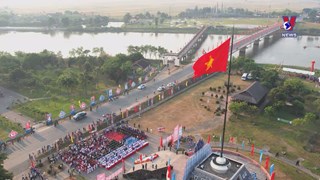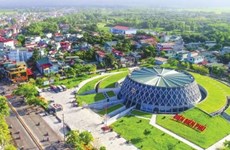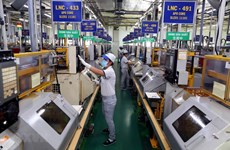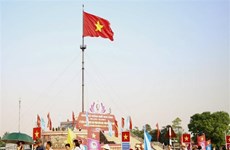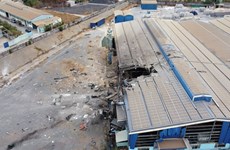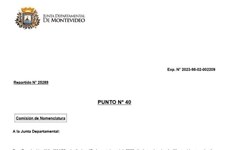Seeking solutions to Vietnam's traffic a headache: officials
The Ministry of Transport has again proposed limiting personal vehicles
in Vietnam's major cities through increased parking fees, in addition to
a congestion charge for vehicles entering city centres. This has caused
concern from experts and the public alike, with many noting that the
long-term plan must be to develop public transportation so there is less
need for personal vehicles.
The Ministry of Transport has again proposed limiting personal vehicles
in Vietnam's major cities through increased parking fees, in addition to
a congestion charge for vehicles entering city centres. This has caused
concern from experts and the public alike, with many noting that the
long-term plan must be to develop public transportation so there is less
need for personal vehicles.
Viet Nam News examines the issue with Tu Sy Sua, former head of the Faculty of Roadway, University of Transport, Hanoi; Associate Professor Nguyen Quang Toan, independent transportation development expert; and Markus Ernst, technical advisor, Environmentally and Climate-Friendly Urban Development in Da Nang, GIZ (German Society for International Cooperation).
- This is not the first time that the Ministry of Transport has suggested measures to limit the use of personal vehicles. Do you think it's feasible to do it now?
+ Tu Sy Sua: The plan reflects the ongoing need to address traffic congestion in Vietnam's major cities. Measures including the imposition of personal vehicle fees when driving in crowded city centres or higher parking fees are just administrative, short-term measures. Instead of restricting personal vehicles, we should develop a transport system in which various types of travel - private or public - are co-ordinated in harmony, offering passengers a range of convenient travel options.
The plan lacks drastic breakthrough measures, such as the development of underground or monorail public transport as our existing bus systems can only meet around 15 per cent of demand.
Moreover, the plan targets only five cities - Hanoi, Ho Chi Minh City, Da Nang, Hai Phong and Can Tho - while other cities across the country including Vinh, Viet Tri and Vung Tau also have similar traffic congestion problems.
In transport development, we should prioritise cities in terms of need and scale. For example, normally cities with a population of at least 1 million people need to consider building an underground system.
+ Nguyen Quang Toan: Cities with populations of 500,000 people can be considered big cities and those with millions are mega-cities. In Vietnam, Hanoi and Ho Chi Minh City can be considered mega-cities and their transport systems are quite much-used and complicated, requiring tens of millions of trips each day.
In Vietnam's big cities, motorbikes now account for 70-80 percent of all travel. With financial competence, it is reasonable for people to expect to own personal vehicles. The switch to other modern advanced means of transportation depends much on peoples' incomes and desires.
Although there is an increase in the ownership of personal vehicles, personal transportation alone will not be able to meet travelling demands in big cities with a high population density. The need to develop public transport is as obvious as the need for multi-storey buildings in urban areas. Imposing bans on personal vehicles in crowded city centres is only a temporary measure and not a proper solution. In the past, Vietnam imposed high taxes on cars and consequently affected automobile production. If the country encourages car ownership and tighten controls including road taxes or fuel taxes, it could raise money for the State budget, promote the automobile industry and adjust consumers' behaviour. When people have available options, they feel less pressured.
+ Markus Ernst: It is a right step in the right direction. However, the introduction of parking fees and traffic fines will not be the total solution. It has to be part of a more comprehensive approach. It is important that the introduction of these fees is reasonably explained to the general public right from the beginning. It is understandable - and the same worldwide - that the introduction of fees causes reservations and public resistance.
But, for example, the introduction of traffic fines in general is also linked to traffic education and helps to ensure traffic safety. It's very important in this case that traffic police are well trained, the fees are transparent and non-discriminatory, while determined steps must be taken against corruption.
- Are personal vehicles to blame for current levels of traffic congestion? How can we become less reliant on motorbikes?
+ Tu Sy Sua: Personal vehicles - including bikes, motorbikes and cars - have advantages because of their high mobility. People can independently decide their journey in terms of time, destination and mode of travel. Riding a bike is good for health and the environment but nowadays, when people want to travel faster in less time and urban areas are continuously expanding, bikes fail to fulfill people's needs.
In Vietnam, people in urban areas are seemingly turning their backs on bikes as a daily means of transportation. The domination of motorbikes and increased usage of cars can be clearly seen. But if the number of personal vehicles keeps increasing, infrastructure including roads and parking areas will become overloaded, exacerbating traffic congestion. As a basic idea in any transport planning, limiting personal vehicles is always taken into account.
+ Nguyen Quang Toan: It is not the number of personal vehicles that causes traffic congestion but the frequency of usage. Now, people mostly rely on personal vehicles, causing traffic jams. If they have their own vehicles but still go to work or school by bus and only use their vehicles in certain cases, it will be much less money.
The proposals on personal vehicle circulation fees or higher parking fees aim to change peoples' personal vehicle habits. However, it will be effective if there is alternative transport means which can meet their minimum requirements, including affordable prices, convenience and punctuality.
+ Markus Ernst: We have to consider that besides the number of motorbikes, the number of private cars is also increasing, already causing a lot of traffic jams and accidents in cities. For sure, if we are talking about reducing the usage of private vehicles, we have to talk about development of a public transport system and to enhance the quality and availability of buses or other means of transport.
But there are also simple changes we can consider and many do not require lots of research, planning and investment. It is important to encourage residents to rely less on their motorbikes and cars, by enhancing the quality of the sidewalks for example. This could include planting trees to shade the sidewalk, banning motorbike parking on sidewalks or introducing parking fees.
- So should we wait to improve our public transport system to then limit personal vehicles?
+ Tu Sy Sua: We can learn from Singapore with its very tight procedures or requirements for operating personal vehicles. So, as soon as someone wants to buy a car, he has to think about the costs, including administrative procedures and taxes which are there to discourage car use. In fact, it is much simpler to use public transportation.
In theory, people would see the bus as a reasonable choice if travelling by bus was faster than by bikes and twice as cheap in terms of time, fuel cost and parking fee. If bus transport could meet these expectations then people would choose it. So, to limit the use of personal vehicles, public transport must be diversified, with improved quality and affordable prices.
The combination of different means of transport is the key to addressing traffic problems in Vietnam's big cities now. Until public transport can meet 20-25 percent of total travelling needs, we should introduce measure to encourage the switch to public transportation use.
Public transport also needs to be developed to be more environmentally friendly, for example by using electric vehicles, renewable energy-run vehicles or those which can carry a large number of passengers at the same time, to save space and energy. Public transport should be more accessible and user friendly for people with disabilities as well.
The Government should continue offering incentives or subsidiaries to promote public transport as a social welfare like healthcare or education.
+ Nguyen Quang Toan: Now is not the right time to restrict personal vehicles because we don't have enough alternatives. Hanoi now has buses which only meet 10 percent of demand. If resources are properly mobilised for transport development and a proper system is developed, it will take decades to ease urban traffic congestion.
It's estimated that by 2020, personal vehicles will still account for 70 percent of traffic in Hanoi and Ho Chi Minh City. Until people are offered proper public transport services, they won't be happy to switch from using highly-mobile personal vehicles to public ones. I think the restrictions for personal vehicles should be piloted on a smaller scale. This could be done in the Old Quarter or the area around Hoan Kiem Lake in Hanoi. This would help citizens get familiar with using personal vehicles less.
+ Markus Ernst: In my view, Da Nang city is taking future transport problems very seriously. Da Nang is still in a good position to take measures to resolve this. City planners can especially learn from experiences in Ha Noi and Ho Chi Minh City. Both cities are examples of congestion and occasional traffic chaos.
In recent years, there has been huge infrastructure investments in Da Nang's roads and bridges, so traffic is still running smoothly most of the time. However, this will change with the increasing number of cars and motorbikes on the road. With the development of the new Bus Rapid Transit System, Da Nang is already on its way to overcoming the future challenges of the transport system./
Viet Nam News examines the issue with Tu Sy Sua, former head of the Faculty of Roadway, University of Transport, Hanoi; Associate Professor Nguyen Quang Toan, independent transportation development expert; and Markus Ernst, technical advisor, Environmentally and Climate-Friendly Urban Development in Da Nang, GIZ (German Society for International Cooperation).
- This is not the first time that the Ministry of Transport has suggested measures to limit the use of personal vehicles. Do you think it's feasible to do it now?
+ Tu Sy Sua: The plan reflects the ongoing need to address traffic congestion in Vietnam's major cities. Measures including the imposition of personal vehicle fees when driving in crowded city centres or higher parking fees are just administrative, short-term measures. Instead of restricting personal vehicles, we should develop a transport system in which various types of travel - private or public - are co-ordinated in harmony, offering passengers a range of convenient travel options.
The plan lacks drastic breakthrough measures, such as the development of underground or monorail public transport as our existing bus systems can only meet around 15 per cent of demand.
Moreover, the plan targets only five cities - Hanoi, Ho Chi Minh City, Da Nang, Hai Phong and Can Tho - while other cities across the country including Vinh, Viet Tri and Vung Tau also have similar traffic congestion problems.
In transport development, we should prioritise cities in terms of need and scale. For example, normally cities with a population of at least 1 million people need to consider building an underground system.
+ Nguyen Quang Toan: Cities with populations of 500,000 people can be considered big cities and those with millions are mega-cities. In Vietnam, Hanoi and Ho Chi Minh City can be considered mega-cities and their transport systems are quite much-used and complicated, requiring tens of millions of trips each day.
In Vietnam's big cities, motorbikes now account for 70-80 percent of all travel. With financial competence, it is reasonable for people to expect to own personal vehicles. The switch to other modern advanced means of transportation depends much on peoples' incomes and desires.
Although there is an increase in the ownership of personal vehicles, personal transportation alone will not be able to meet travelling demands in big cities with a high population density. The need to develop public transport is as obvious as the need for multi-storey buildings in urban areas. Imposing bans on personal vehicles in crowded city centres is only a temporary measure and not a proper solution. In the past, Vietnam imposed high taxes on cars and consequently affected automobile production. If the country encourages car ownership and tighten controls including road taxes or fuel taxes, it could raise money for the State budget, promote the automobile industry and adjust consumers' behaviour. When people have available options, they feel less pressured.
+ Markus Ernst: It is a right step in the right direction. However, the introduction of parking fees and traffic fines will not be the total solution. It has to be part of a more comprehensive approach. It is important that the introduction of these fees is reasonably explained to the general public right from the beginning. It is understandable - and the same worldwide - that the introduction of fees causes reservations and public resistance.
But, for example, the introduction of traffic fines in general is also linked to traffic education and helps to ensure traffic safety. It's very important in this case that traffic police are well trained, the fees are transparent and non-discriminatory, while determined steps must be taken against corruption.
- Are personal vehicles to blame for current levels of traffic congestion? How can we become less reliant on motorbikes?
+ Tu Sy Sua: Personal vehicles - including bikes, motorbikes and cars - have advantages because of their high mobility. People can independently decide their journey in terms of time, destination and mode of travel. Riding a bike is good for health and the environment but nowadays, when people want to travel faster in less time and urban areas are continuously expanding, bikes fail to fulfill people's needs.
In Vietnam, people in urban areas are seemingly turning their backs on bikes as a daily means of transportation. The domination of motorbikes and increased usage of cars can be clearly seen. But if the number of personal vehicles keeps increasing, infrastructure including roads and parking areas will become overloaded, exacerbating traffic congestion. As a basic idea in any transport planning, limiting personal vehicles is always taken into account.
+ Nguyen Quang Toan: It is not the number of personal vehicles that causes traffic congestion but the frequency of usage. Now, people mostly rely on personal vehicles, causing traffic jams. If they have their own vehicles but still go to work or school by bus and only use their vehicles in certain cases, it will be much less money.
The proposals on personal vehicle circulation fees or higher parking fees aim to change peoples' personal vehicle habits. However, it will be effective if there is alternative transport means which can meet their minimum requirements, including affordable prices, convenience and punctuality.
+ Markus Ernst: We have to consider that besides the number of motorbikes, the number of private cars is also increasing, already causing a lot of traffic jams and accidents in cities. For sure, if we are talking about reducing the usage of private vehicles, we have to talk about development of a public transport system and to enhance the quality and availability of buses or other means of transport.
But there are also simple changes we can consider and many do not require lots of research, planning and investment. It is important to encourage residents to rely less on their motorbikes and cars, by enhancing the quality of the sidewalks for example. This could include planting trees to shade the sidewalk, banning motorbike parking on sidewalks or introducing parking fees.
- So should we wait to improve our public transport system to then limit personal vehicles?
+ Tu Sy Sua: We can learn from Singapore with its very tight procedures or requirements for operating personal vehicles. So, as soon as someone wants to buy a car, he has to think about the costs, including administrative procedures and taxes which are there to discourage car use. In fact, it is much simpler to use public transportation.
In theory, people would see the bus as a reasonable choice if travelling by bus was faster than by bikes and twice as cheap in terms of time, fuel cost and parking fee. If bus transport could meet these expectations then people would choose it. So, to limit the use of personal vehicles, public transport must be diversified, with improved quality and affordable prices.
The combination of different means of transport is the key to addressing traffic problems in Vietnam's big cities now. Until public transport can meet 20-25 percent of total travelling needs, we should introduce measure to encourage the switch to public transportation use.
Public transport also needs to be developed to be more environmentally friendly, for example by using electric vehicles, renewable energy-run vehicles or those which can carry a large number of passengers at the same time, to save space and energy. Public transport should be more accessible and user friendly for people with disabilities as well.
The Government should continue offering incentives or subsidiaries to promote public transport as a social welfare like healthcare or education.
+ Nguyen Quang Toan: Now is not the right time to restrict personal vehicles because we don't have enough alternatives. Hanoi now has buses which only meet 10 percent of demand. If resources are properly mobilised for transport development and a proper system is developed, it will take decades to ease urban traffic congestion.
It's estimated that by 2020, personal vehicles will still account for 70 percent of traffic in Hanoi and Ho Chi Minh City. Until people are offered proper public transport services, they won't be happy to switch from using highly-mobile personal vehicles to public ones. I think the restrictions for personal vehicles should be piloted on a smaller scale. This could be done in the Old Quarter or the area around Hoan Kiem Lake in Hanoi. This would help citizens get familiar with using personal vehicles less.
+ Markus Ernst: In my view, Da Nang city is taking future transport problems very seriously. Da Nang is still in a good position to take measures to resolve this. City planners can especially learn from experiences in Ha Noi and Ho Chi Minh City. Both cities are examples of congestion and occasional traffic chaos.
In recent years, there has been huge infrastructure investments in Da Nang's roads and bridges, so traffic is still running smoothly most of the time. However, this will change with the increasing number of cars and motorbikes on the road. With the development of the new Bus Rapid Transit System, Da Nang is already on its way to overcoming the future challenges of the transport system./
